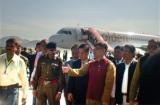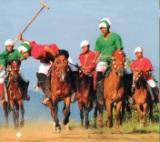The Sangai Festival of Manipur
 The Sangai Festival of Manipur
The Sangai Festival of Manipur
State's Festival to benefit from the upgrade of state Airport to International Status
Manipur is one of the seven sister states of the North East Region of India which has been given various names like Switzerland of East India and the Jewel of India. This little corner is a paradise on Earth and its pristine beauty is a boon given by nature.This little corner of India today remains largely untouched and vastly undiscovered and promises to be the great tourist discovery of the 21st Century.
The Manipur valley is surrounded by blue green hills and its wealth in art and tradition has inspired description such as the ‘Switzerland of the East’ with its cascading rapids, meandering rivers, varieties of flora and fauna and lakes. The people of Manipur include the Meitei, Nagas, Kukis, Meitei-Pangals and other communities which have lived in complete harmony for centuries. These are the people whose folklore, myths and legends, dances, indigenous games and martial arts, exotic handlooms and handicrafts are invested with the mystique of nature and an indefatigable “Joice de Vivre”. And this is not the end of it.
These are the people whose folklore, myths and legends, dances, indigenous games and martial arts, exotic handlooms and handicrafts are invested with the mystique of nature and an indefatigable “Joice de Vivre”. And this is not the end of it.
Manipur is a mosaic of ancient tradition and rich cultural patterns. In the field of art and culture, the State is best represented by its classical dance. The well - known Raas Dance depicts the dance of Lord Krishna andwith Gopies (Milkmaids) of Brindavan, and express their yearning for communion with the Lord. Another spring festival, the Lai-Haraoba held in April, May is symbolized by a traditional stylized and ritualistic dance performed for peace and prosperity. The urban folk dances are an expression of nature, creativity and aestheticism of the tribal way of life. One will be charmed by the colourful of life, colourful costumes, dance and unique rituals in festivals such as Lui-Ngai-Ni (Seed rowing festival of Nagas of Manipur) an annual event. The culture of the Naga tribes of the State is showcased on the stage of the Kut Festival (the largest festival of Kuki-Chin-Mizo communities) an annual event and a State holiday.
The handloom and handicrafts items of Manipur are rare souvenirs for tourists and are an indispensable aspect of the socio - economic life of the people here. There are more than 33 different communities in the State having their peculiar designs of traditional and indigenous handloom fabrics. Manipur pottery is crafted without a potter’s wheel. It is a rare experience to witness the potters of Andro, Thongjao and Nungbi deftly moulding an unbelievable range of earthenware. Beautiful pieces of earth made of cane and bamboo from an important part of the handicrafts of the State.
Manipur, besides being the power house of sports in India, has many of its own indigenous sports. The traditional sports of Thang Ta and Sarit Sarak (Manipuri Martial Arts) date back to the ancient history of Manipur, the traditions of which had been passed down over the centuries. They are very energetic and skilful arts and are ways to hone ones battle craft during the olden days when Manipuri warriors were required to serve their country at the time of war.
 Mukna (Manipur Wrestling) is played between two male rivals as a trial of strength and skill. Mukna is a highly popular and prestigious game which enjoyed royal patronage in ancient times.
Mukna (Manipur Wrestling) is played between two male rivals as a trial of strength and skill. Mukna is a highly popular and prestigious game which enjoyed royal patronage in ancient times.
Yubi Lakpi is the Manipuri style of Rugby where ‘Yubi’ means a coconut and ‘Lakpi’ means snatching in the Manipuri language. Here each side has 7 players in a field of 45x18 metres in area. One end of the field has a rectangular box of 4.5x3 metres, one side of which forms the central portion of the goal line to score a goal, a player has to approach the goal from the front with his oiled coconut and pass the goal line.
Hiyang Tannaba (Boat Race) is generally held in the month of November at Thangapat and Loktak Lake. The boats called ‘Hiyang Hiren’ are believed to be invested with spiritual powers and the game is associated with religious rites. The game is also conducted during times of natural calamity.
Kang is a game which is played on the mud floor of a big out-house, fixed targets are hit with the ‘Kang’ which is a flat and oblong object made of either ivory or lac. Normally each team has 7 male partners. The game is also played as a mixed doubles contest.
Coming to Sagol Kangjei (Polo), the Manipuri Sagol Kangjei has been adopted by the international community as Polo and is now being played worldwide. A little known of fact is that Polo has its origin in Manipur. The ‘Puyas’ trace it to the mythological age when the game was played by Gods. The game is played with 7 players on each side mounted on ponies which are often not more than 4/5 feet height. Each player is outfitted with a polo stick made of cane having a narrow angled wooden head fixed at the stiking end. The ball is made of bamboo root. The British learned the game of Sagol Kangjei (Polo) is the 19th century from Manipur and after refinement it was taken to the rest of the world as Polo.
Manipur is not just a gateway to the Northeastern region but is also a fascinating destination for tourists. Blessed with a salubrious climate and languishing in natural beauty and scenic  splendour, it invites the tourists to visit again and again. Really it is a ‘pavadesi’ on the tourists.
splendour, it invites the tourists to visit again and again. Really it is a ‘pavadesi’ on the tourists.
Another big feature on the annual calendar of events is the annual Sangai Festival. The Sangai is the name of the brow-antlered deer which is found only in Manipur. One can see the Sangai at Keibul Lamjao National Park, the only floating park in the world. This year, the theme of the Manipur Sangai Festival, 2013 was ‘Time waits when Manipur celebrates’.
Every year the Government of Manipur, spearheaded by the Tourism Department, celebrates the Manipur Sangai Festival from 21st to 30th of November. The festival strives to showcase and promote the best of what the State has to offer to the world in terms of art and culture, handloom and handicrafts, indigenous sports, cuisine and music, eco and adventure sports as well as the scenic natural beauty of the land. Moreover, the festival has assumed great significance in recent years and the 2013 edition essentially celebrates the ethnic diversity of Manipur’s society. The participation of various Indian States, foreign traders and cultural troupes in the festival this year has make it grander in scale and style. Side by side, the Imphal airport will now be an International Airport in connection with the festival. For the first time, the Golden Myanmar Airlines touched down on Imphal airport. Mr. Pawan Singh, Ghatowar, Union DONER Minister inaugurated the maiden flight. Besides, this many foreign tourists from, China, Thailand, Taiwan, Myanmar and other countries are going to witness the great Sangai Festival.
 With the approval given by the Director General of Civil Aviation (DGCA) to the Myanmarese private airlines, Golden Myanmar to use the Tulihal Airport, Imphal, as a part of India’s Look East Policy, preparations are being made for the elevation of the airport at Imphal to the status of an International Airport.
With the approval given by the Director General of Civil Aviation (DGCA) to the Myanmarese private airlines, Golden Myanmar to use the Tulihal Airport, Imphal, as a part of India’s Look East Policy, preparations are being made for the elevation of the airport at Imphal to the status of an International Airport.
A milestone was achieved as the State’s Tulihal Airport entered the list of airport with international flight services. The first international flight from Myanmar carrying around 200 delegates along with the two Chief Ministers of Mandalay and Sagain regions touched down at Imphal Airport on the 21st of November 2013. They were warmly welcomed at the airport by the State’s Chief Minister and his council of ministers and other officials.
At about 4:00 p.m. the same day, the biggest annual tourism festival of the State, the 10 - day long Sangai Festival kicked - off and was inaugurated by the Union DONER Minister Paban Singh Ghatowar which was witnessed by the foreign delegates, VIP’s and representatives from NGOs and the general public.
After the inaugural function, a special cultural show followed with great pomp and show. Like every year, the main attraction of the festival is going to be the performances by cultural troupes from foreign countries like Myanmar and Thailand.
Apart from stalls exhibiting an array of different indigenous products of handlooms and handicrafts there were also those offering indigenous cuisines at the main venue of the festival at Hapta Kangjeibung. Indigenous sports will also be showcased each day of the festival at Historic Mapal Kangjeibung where the 7th Manipur Polo International Tournament, 2013 is already underway.
In addition to this, to ensure that no untoward incident occurs during the festival, police and other paramilitary forces have been deployed in and around the festival venues. Besides this, many media persons from the State and other parts of the country are covering this festival.
Furthermore, many entertaining items like fashion shows, rock shows, theme district days, local delicacies, multi-colour cultural shows etc. were organised to attract domestic and foreign tourists to the festival. The Festival is the right venue for innovative people with innovative ideas meet on a common platform.
This is the right time especially for the North East people to get together and come together at the Sangai Festival

